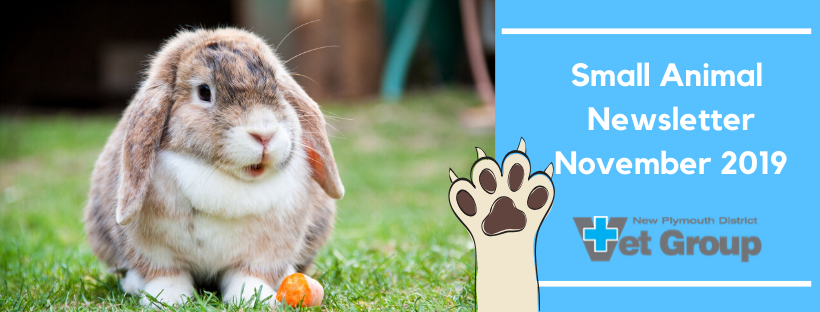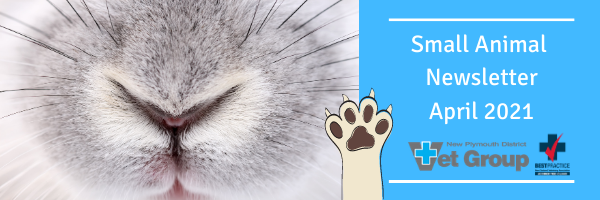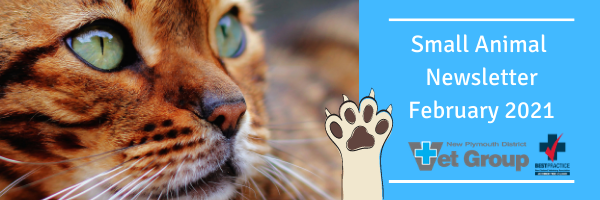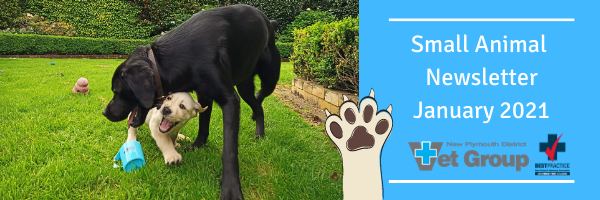We now offer Low Level Laser Therapy (LLLT also known as Photobiomodulation) Recently, we started offering…

Small Animal Newsletter – November 2019
Preparing for the holiday season
 The year is rapidly drawing to a close and many of us are eagerly awaiting our summer holidays. There are so many things to finalise and we would like to draw your attention to a few pet-related matters at this time of the year.
The year is rapidly drawing to a close and many of us are eagerly awaiting our summer holidays. There are so many things to finalise and we would like to draw your attention to a few pet-related matters at this time of the year.Remember to make arrangements for your pets while you are on holiday. Options range from kennels and catteries to house sitters or family members who can take care of your pets. If you are getting someone to look after your pets in their home environment, make sure you introduce them to that person beforehand and that they are aware of any nutritional and medical needs. Stock up on food and any prescriptions your pet might require and check that their flea and worm treatments are up to date.
Vaccinations
Your pet’s vaccinations need to be up to date for them to board at a kennel or cattery. If your pets are due we suggest booking an appointment early rather than later to avoid the disappointment of missing out. The kennels and catteries will not accept a vaccination done the morning of the kennel admission and some vaccinations have a stand-down period of 10 days before they can enter a boarding facility. If in doubt, check with us and we can advise you accordingly.
Microchipping
Many pets go missing during the holiday season. A microchip enables us to find an owner should you lose or find a pet. Microchipping is quick and relatively painless. Your pet can be registered on the local or national database and if they get lost at least you can be contacted.
Travelling with your pets
 If you are taking your pets with you, make sure the accommodation you are using is pet-friendly. Lots of pets get car sick or nervous about travelling especially for long periods of time. Book an appointment to see a vet if this is the case beforehand and we can dispense the correct medication to make your trip less stressful. Also, rescue remedy can be useful to help calm them down while travelling. Taking your pet’s bed with you can help them feel more secure and relaxed in a new environment. Make sure where they are staying is secure and that they can not get out and get lost. If they do get out they will be very disorientated in their new environment. Again making sure they are microchipped.
If you are taking your pets with you, make sure the accommodation you are using is pet-friendly. Lots of pets get car sick or nervous about travelling especially for long periods of time. Book an appointment to see a vet if this is the case beforehand and we can dispense the correct medication to make your trip less stressful. Also, rescue remedy can be useful to help calm them down while travelling. Taking your pet’s bed with you can help them feel more secure and relaxed in a new environment. Make sure where they are staying is secure and that they can not get out and get lost. If they do get out they will be very disorientated in their new environment. Again making sure they are microchipped.While travelling we suggest stopping every 1 – 2 hours to allow your pet to have some water, stretch their legs and go to the toilet. If your dog gets excited in the car, it can help to stop about 20 mins after you start travelling to let them get out and have a sniff – often they will settle down more quickly.
Always travel with cats in a cat box or crate. Do not let them roam free in the car as this can be very dangerous. It’s a good idea to let cats get used to travelling in a box or crate a week or two before your departure. Put the box in a favourite area of your house so they can get used to it. Feeding them in it will help them feel safe and secure.
Checklist:
- Check vaccination status if you are putting them in a Kennel or Cattery
- Stock up on their food
- Order more prescription medication
- Make sure your pets are up to date with their flea, tick and worm control.
- Are they microchipped? If not, book them in.
Enjoy the holiday season and we hope that you and your pets get an opportunity to rest and spend valuable time together!
Ten tips to help feed a fussy dog
Not all dogs are created equal when it comes to food. Some dogs “live to eat”, and others “eat to live”! It’s probably fair to say that most Labradors fall into the “live to eat” category, while many other breeds – often smaller dogs – by nature may not be quite so keen on eating. Of course, there are those others who have been programmed to be fussy eaters by their well-wishing pet parents! Who wouldn’t want to eat yummy steak, bacon titbits etc off your plate rather than boring (but healthy!) dog food?
If you do have a fussy eater, here are a few tips that may help you out:
1. If you feed dry kibble, choose one made with high-quality ingredients. Check the label on the back, look for named meats (no by-products) as the first ingredients.
2. Add a little warm water to his kibble. This releases all the aromas of the ingredients in the biscuit.
3. Add a couple of spoons of canned food to his kibble.

4. Add a couple of spoons of yoghurt, sardines, mackerel or vegetables. Mix in with the kibble or put in his bowl first, and put the kibble on top – that way he has to eat the biscuits first!
5. A little tough love can be helpful. If your pooch won’t eat his meal after 10-15 minutes, take it away and do not feed him until the next mealtime. Dogs don’t necessarily need to eat every day – particularly if they do not have a good exercise routine – they simply may not be hungry.
6. Rotate his food. Choose a different meat or fish protein when you buy the next bag of food. Always remember to mix the new food into the existing food over a number of meals. If you choose a simple formula food (limited ingredient or formulated for sensitive stomachs) it will be easier to rotate.
7. A reluctant eater may take food from your hand, and can then be transitioned to eat from the bowl. Some dogs will respond to scattering the kibble over the ground, activating their natural instinct for scavenging.
8. Feed a little less of their food than recommended. They are more to have more of an appetite at the next mealtime. Many dogs today are overfed. Remember if you’re feeding a good quality food, you’re likely to feed a lot less than lesser quality foods.
9. Keep treats to a minimum. Again, to make them more hungry when it gets to mealtimes (much like children).
10. Always make mealtimes a pleasant time. Be excited to get his food ready. Encourage a bit of excitement and anticipation.
Source: https://www.healthypetfoods.co.nz/health-nutrition/ten-tips-to-help-feed-a-fussy-dog
Nutritional requirements for your pet rabbit

Rabbits can be extremely fussy so starting out on the right track and sticking to appropriate food from the beginning is very important.
- 80-90% of the diet should be made up from good quality hay, and fresh grass (not lawn clippings). A 2kg rabbit can eat about a cat litters tray worth of hay daily!
Rabbits can be fussy about poor quality hay. If it is green, smells nice and is not dusty this is a good start. Put the hay in their favourite nesting places in hay racks and it can also be packed into toys for activity feeding (stuffed through toilet rolls or into willow balls or hanging baskets).
- Vegetables can make up 10-20% of the diet. This can include any of the following:
- Bok Choy, carrot tops (the green leaves), celery, broccoli, cabbage and cauliflower leaves.
- Wild greens such as dandelion, chicory, milk thistle and puha.
- Herbs such as coriander, mint, parsley and oregano.
- Good quality dry food can be given in small amounts only making up only 5% of the diet along with treats such as fruits and some types of vegetables.
Dry pellets are not an essential part of the diet and should be given in a limited amount of no more than 25gm per kg or rabbit.
Avoid rabbit ‘meusli’ mixes which contain ingredients that rabbits would never naturally forage on in the wild (rolled oats, sweet corn, dried peas and sunflower seeds). These mixes encourage selective feeding leading to an imbalanced diet, and are too high in starches which encourage weight gain and poor calcium intake (another cause of dental disease in rabbits).
- Fruits and vegetables that can be given in small amounts:
- Apples, bananas, grapes, strawberries, watermelon and tomatoes
- Red, orange and green capsicum.
Special care needs to be taken
Rabbits are also special in that they have a behaviour called caecotrophy (night time poo). This special poo is full of vitamins and amino acids, which is eaten by the rabbit to increase the nutrition they get from their diet. Some rabbits do not eat these night poo’s resulting in accumulation of caecotrophs around their bottom. These poos are soft and sticky and can create a smelly pancake around the bottom leading to life-threatening flystrike.
Failing to eat caecotrophs can be a sign of a health problem such as arthritis or obesity and makes the rabbit at risk of life-threatening fly strike – please make an appointment with the vet if this is happening on a frequent basis and check you rabbits bottom is clean daily especially during the summer months. Rabbits are more likely to their eat caecotrophs is their diet is high in fibre (hay and grass).
For more information about looking after rabbits visit our website here.
How to manage hairballs in my cat?
If you’re a cat owner, you’ve likely experienced this scenario: Your cat’s body starts to undulate while she makes hacking and gagging noises. The next moment, a tubular, slightly slimy ball of fur sits on your floor.
The item most likely is a hairball, a wad of fur that collects in a cat’s stomach when she grooms herself.
Because of the backwards-pointing barbs on a cat’s tongue, the grooming action causes a cat to swallow a lot of dead hair. If the hair collects in the cat’s digestive system more rapidly than the cat can naturally pass it, the hair often comes back up in the form of the slimy hairballs.
5 Tips to prevent hairballs
1. Brush your cat, especially when they are moulting. Removing the loose and dead hair from your cat’s coat before your cat can ingest it is probably the best way to prevent hairballs.
2. Feed your cat a special food formulated to help treat hairballs. We recommend Hills Science Diet Hairball Control – this diet is formulated with higher amounts of fibre to help move hair through a cat’s digestive tract and has enzymes that help break down hair. Always check with your vet before switching to a hairball formula.
3. Give your cat a hairball remedy. Cat Lax prevents hairballs, settles stomachs and improves digestion in cats. It is easy to administer and very palatable. You can squeeze it out over their food or smear it down their front leg to encourage them to lick it off.
4. Keep your cat active with regular playtimes. Regular exercise helps your cat’s digestive system working at its peak efficiency to keep the hair moving through the system instead of collecting into clumps. Also helps with weight control too.
5. Give your cat plenty of water. Dehydration can affect your cat’s digestion and lead to hairballs. Offer your cat fresh water every day.
Dog Wash open 24/7

Have you tried our Dog Wash before? Bring Rover in and wash him in our secure, self-service, 24/7 dog washing facility. Located beside our car park is our amazing K9000 Dog wash station. This coin/note operated machine is a do-it-yourself dog washing unit where for as little as $10 you can wash and dry your pooch, using the supplied Vet-approved shampoos and conditioners.
The easy-to-use unit offers a warm-water wash with the following options :
- Shampoo
- Creme Conditioner
- Flea Shampoo
- and a warm blow dry to finish
If your dog is less than enthusiastic about being washed you can secure him in the unit with the leads provided, and the enclosure is fully fenced to ensure that even when you are finished with your wash, your dog is safe and sound until you say it is time to go!
The unit is incredibly easy to use and our regular customers tell us that they will never go back to the old “hose and bucket” routine. Feel free to come and check it out.
Staff Showcase
Paula Kirk – Vet Nurse

Our Instagram Superstar
These two golden girls are regular visitors to the vet group, usually just popping in for a quick nail trim. They are just adorable!
Have you checked out our Instagram page yet? Updated daily – Meet our pet visitors and patients! Click here!






